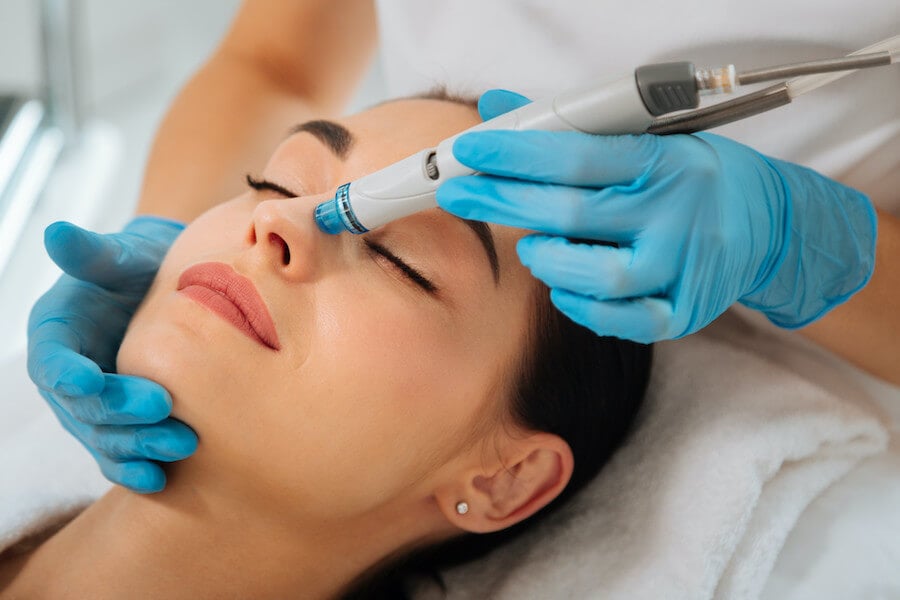Fibroblast skin tightening is a newer, non-surgical cosmetic treatment that can help tighten and improve the appearance of sagging skin on areas like the face, neck, knees, arms, and stomach. This innovative therapy uses plasma energy to stimulate collagen production and tighten loose, aging skin without surgery or injections.
How Fibroblast Skin Tightening Works
Fibroblast therapy is a nonsurgical treatment that uses a pen-like device and the power of plasma to tighten and smooth the skin. The plasma pen is used to discharge a series of tiny plasma flashes (electric current) on the treatment area.
The plasma is emitted in a quick popping motion along the skin’s surface. This targeted current of ionized gas gently heats the outermost skin layer, causing micro-injuries to the tissue. The micro-injuries trigger the body’s natural healing process, stimulating fibroblast cells in the dermis.
Fibroblasts are protein-producing cells in the dermis layer of skin that generate collagen, elastin, and other tissue components. The micro-injuries from the plasma pen kick fibroblast activity into high gear. The fibroblasts immediately begin producing proteins like collagen to repair the skin.
Over the next 8-12 weeks as the skin heals, new collagen production results in tightened, denser tissue with improved elasticity and firmness. The treatment remodels and regenerates the skin for a natural tightening and rejuvenating effect.
Benefits of Plasma Fibroblast Therapy
There are many benefits that make fibroblast plasma skin tightening an appealing alternative to laser resurfacing, chemical peels, fillers, and plastic surgery procedures:
- Non-Invasive Procedure: Fibroblast is a nonsurgical treatment that tightens skin without incisions, anesthesia, or downtime. There is very little pain or discomfort during the procedure.
- Natural Looking Results: Fibroblast therapy tightens sagging skin in a gradual, natural way for subtle, smooth results. It does not have an overly tight or artificial look.
- Minimal Side Effects: Some pinpoint bleeding, redness, swelling, and scabbing may occur after treatment. These side effects typically resolve within 1-2 weeks. There are no lasting side effects.
- Long Lasting Results: Skin tightening results from fibroblast treatment are permanent. The effects can last several years or longer depending on your skin’s aging process.
- Little to No Downtime: Most patients resume normal activities immediately after the treatment. Some swelling or redness may be present for a couple days.
- Improves Multiple Signs of Aging: Fibroblast therapy can improve wrinkles, fine lines, loose skin, enlarged pores, and uneven texture for overall rejuvenation.
- Safe for All Skin Types: Plasma fibroblast can be used safely on all skin types and colors. It is even safe for thin, delicate skin areas like the eyelids and neck.
How to Prepare for Fibroblast Skin Tightening
There are a few important steps to take before your fibroblast skin tightening treatment:
- Avoid Sun Exposure: Stay out of the sun for at least 2 weeks before your treatment. Tanned skin cannot be treated.
- Stop Retinoids and Acids: Discontinue use of retinoids, retinol, and alpha hydroxy acids for 1 week prior. This helps avoid sensitivity.
- Shave Treatment Area: Men need to shave facial hair in treatment areas the day of the appointment. Avoid waxing or plucking for 6 weeks pre-treatment.
- Wash Skin: Make sure treatment areas are clean. Do not apply lotion, oil, makeup, sunscreen, etc on the day of treatment.
- Pain Relief: Some numbing cream may be applied before the procedure to maximize comfort. Oral pain medication can also be taken beforehand.
- Relax: There are no special preparations needed. Just relax and arrive with clean skin for your treatment.
What to Expect During the Fibroblast Procedure
Here is a step-by-step overview of what happens during a typical fibroblast skin tightening session:
- The provider will cleanse and prepare the treatment area. Numbing cream is applied and left to take effect for about 30 minutes. This helps make the treatment comfortable.
- The plasma pen is tested and calibrated on a practice skin area. When it touches the skin, a popping sound is heard and a small brown dot appears.
- The pen is then glided along the skin’s surface to create a pattern of tiny plasma flashes. Each flash hits the skin for just a fraction of a second. You will hear continuous popping sounds as the pen is moved around the treatment area.
- The plasma flashes feel like a hot pricking sensation. The heat helps to make this treatment tolerable. Some areas like the eyelids and lips are more sensitive.
- Your provider tailors the plasma intensity and number of passes based on your skin laxity and treatment goals. One pass is often sufficient for subtle tightening.
- The procedure takes about 30-60 minutes depending on the size of the treated area. Numerous small areas like the eyelids can be treated in a single session.
- Immediately after the treatment, the skin appears speckled with tiny brown dots from the plasma. The treated area may be slightly swollen, red, and tender. Cold air and aloe vera gel help soothe the skin.
Recovery After Fibroblast Skin Tightening
The recovery period after fibroblast therapy is short and simple for most patients. Here is what to expect:
- Treated skin may remain red, swollen, and tender for 2-3 days after the procedure. Cold compresses and OTC pain medication can provide relief.
- Tiny scabs form over the plasma dots within 24 hours. The scabs protect new collagen forming underneath.
- Scabs fall off naturally over 7-14 days. Do not pick or scratch them. Gentle cleansing and moisturizer keep the skin calm.
- Once scabs detach, the skin unveils looking smoother, firmer, and more toned. However, final results emerge over the next 8-12 weeks.
- Makeup can usually be worn to cover redness after 5-7 days. Avoid makeup on the treated area until scabs have fallen off.
- Avoid direct sun exposure until skin is fully healed. Always wear SPF 30 or higher afterwards to maintain results.
- Strenuous exercise, facials, and saunas should be avoided for 2 weeks post-treatment.
- Additional treatments may be done every 4-6 weeks if needed to achieve desired tightening. Most patients only need 1-3 sessions.
Who Is a Good Candidate for Fibroblast Therapy?
Fibroblast skin tightening can improve signs of aging for many individuals who are bothered by sagging skin. Good candidates include:
- Those in their late 30s to 60s with mild to moderate skin laxity. Fibroblast is ideal for people just starting to see signs of facial aging.
- People who want to tighten and lift drooping eyelids, eyebrows, jawline, and neck.
- Individuals concerned about wrinkles and fine lines around the eyes, lips, cheeks, and forehead.
- Anyone looking to tighten loose stomach skin after pregnancy or weight loss.
- Those seeking improvement in cellulite, acne scars, and stretch marks on the body.
- People wanting subtle rejuvenation without prolonged downtime or radical change.
- Individuals who are not yet ready for a facelift or other invasive procedures.
- Anyone unable to undergo surgery due to health conditions.
- Those wanting natural-looking results that do not appear overdone.
Fibroblast may not be recommended for people with very thin or fragile skin. Your provider can help determine if you are a good candidate during an initial consultation.
Target Areas for Fibroblast Skin Tightening
Some of the most popular areas of the skin treated with fibroblast plasma therapy include:
Face
- Forehead – reduces transverse wrinkles and frown lines
- Eyebrows – lifts drooping brows
- Eyelids – tightens and lifts sagging upper and lower lids
- Under eyes – improves wrinkles, bags, and dark circles
- Cheeks – lifts sagging skin and smooths wrinkles
- Upper lip – reduces vertical lip lines
- Neck – tightens crepey skin and horizontal neck bands
Body
- Stomach – tightens loose, sagging skin after pregnancy or weight loss
- Buttocks – lifts, tightens, and smooths the skin
- Inner thighs – improves loose, dimpled skin
- Knees – tightens crepey knee skin
- Upper arms – tightens and smooths loose skin and wrinkles
Smaller areas like the jawline, chin, chest, elbows, and hands can also benefit from fibroblast skin tightening.
How Many Fibroblast Treatments Are Needed?
Most patients see noticeable improvements in skin tightness and tone after just one fibroblast session. However, the number of treatments needed depends on factors like your skin laxity and goals.
On average, 1-3 treatments spaced 4-6 weeks apart are recommended for optimal results. Treating smaller surface areas like the eyelids or neck may require fewer sessions than larger areas like the abdomen.
Your practitioner can advise how many fibroblast treatments are ideal at your initial consultation. Maintaining a healthy lifestyle and skin care routine helps prolong the effects. Annual touch-up sessions may be desirable to combat the ongoing aging process.
The effects of plasma fibroblast therapy are considered permanent because new collagen and elastin fibers are produced in the dermis. However, these skin proteins naturally degrade over time. Results typically last at least 1-3 years or longer before a maintenance session is needed.
Side Effects and Risks of Fibroblast Treatment
When performed correctly by an experienced professional, fibroblast therapy is considered very safe with minimal risks. However, some possible side effects include:
- Discomfort/pain during the procedure that resolves quickly
- Short-term redness, swelling, bruising, and tenderness
- Small brown dots and scabbing as the skin heals
- Pinpoint bleeding and oozing from treatment sites
- Infection risk if aftercare instructions are not followed
- Hyperpigmentation that usually fades within weeks
- Mild textural changes like bumps or dents from plasma dots
- Insufficient results if poor techniques are used
The risks associated with fibroblast can be avoided by choosing an expert provider and following proper post-treatment guidelines. More serious risks like scarring and pigmentation issues are very rare.
Cost of Fibroblast Skin Tightening Treatments
Like most cosmetic procedures, the cost of fibroblast plasma therapy depends on your treatment provider and geographic location. On average, the cost per session ranges from:
- $500 – $1500 for smaller areas like the eyes, neck, or jowls
- $1000 – $3000 for mid-size areas like the face, breasts, or knees
- $1500 – $5000 for larger body areas like the arms, abdomen, or buttocks
In general, fibroblast skin tightening costs less per treatment than surgical facelifts, eyelid surgery, or laser skin resurfacing. Maintenance sessions every 1-3 years are typically quicker and cheaper than the initial treatment cost. The first step would be to schedule a consultation with Stacie by calling (480) 439-2308.
Comparison to Other Skin Tightening Procedures
How does plasma fibroblast treatment compare to other popular skin tightening options? Here is an overview:
- Laser Skin Resurfacing – Ablative and fractional laser treatments can effectively resurface and tighten skin. However, they involve more pain, longer downtime, and higher risk of scarring or pigment changes than fibroblast. Multiple sessions are usually required.
- Chemical Peels – Light chemical peels provide mild improvements, but only superficial peeling agents can be used due to downtime. Results are not as dramatic or long-lasting as fibroblast. Repeated treatments needed.
- Microneedling – This collagen-boosting treatment uses tiny needles to puncture the skin. It does not heat or damage tissue like fibroblast plasma, so its tightening ability is more limited. Requires a series of sessions.
- Thermage – This radiofrequency device heats the deeper dermis to stimulate collagen. It can tighten skin without surgery, but results are more gradual and incremental than fibroblast. Multiple treatments are recommended.
- Ultherapy – Focused ultrasound is used to target and heat the skin’s foundational layers. Tightening occurs over 2-3 months. Fibroblast may cause less discomfort yet provide faster, more noticeable tightening.
- Plastic Surgery – Surgical facelifts, neck lifts, and eyelid surgery offer more aggressive, dramatic lifting of sagging skin. But surgery comes with extended downtime, risks, and a higher price tag than non-invasive fibroblast.
For individuals who want moderate skin tightening with minimal downtime, fibroblast plasma therapy provides an effective option. It can be used alone or combined with other treatments like laser resurfacing for a synergistic rejuvenating effect.
Caring for Skin After Fibroblast Treatment
Proper aftercare is vital for healing safely after fibroblast plasma skin tightening. Here are some tips:
- Keep treated areas clean by gently washing with mild soap and water 1-2 times a day. Avoid scrubbing or irritating the skin.
- Use a gentle, fragrance-free moisturizer like Cetaphil to keep the skin hydrated as it heals. Avoid scented lotions or oils.
- Wear a mineral SPF 30 or higher sunscreen daily to protect treated skin. Limit sun exposure.
- Apply a thin layer of antibiotic ointment like Polysporin to the plasma dots to prevent infection and speed healing.
- Avoid picking at scabs. Let them detach naturally as the skin renews itself.
- Stay out of pools, saunas, steam rooms for 2 weeks post-treatment until skin is healed.
- When showering, keep water lukewarm, not hot. Pat skin dry, don’t rub vigorously with towels.
- Sleep on your back with head elevated if possible to minimize swelling.
- Avoid strenuous exercise for 10-14 days to prevent sweating and irritation of treated areas.
- Do not have facials, chemical peels, microdermabrasion, or laser treatments until skin is fully healed.
By caring for your skin after fibroblast therapy, you can ensure safe healing and optimize your rejuvenated results. Be sure to follow your provider’s customized post-treatment instructions.
Fibroblast for Skin Tightening: The Bottom Line
Fibroblast plasma therapy is an innovative nonsurgical treatment that uses plasma energy to tighten sagging skin on the face, eyelids, neck, and body. It stimulates new collagen production and healthy tissue regeneration for gradual, natural-looking results with minimal downtime.
This breakthrough skin tightening method provides an alternative to facelifts, laser resurfacing, injectable fillers, and other invasive anti-aging procedures. Fibroblast can improve wrinkles, lines, loose skin, and textural issues on the face and body after just 1-3 sessions.
When performed by an experienced, qualified technician, fibroblast treatment is safe and effective. Taking proper care of your skin after the procedure is crucial. Results continue improving over the next 8-12 weeks and can last several years.
If you are bothered by mild to moderate skin laxity or wrinkles, fibroblast plasma therapy may be a great option to rejuvenate and tighten your appearance without surgery. Schedule a consultation to see if you could benefit from this innovative tightening treatment.
Want more information? Let’s schedule a consultation. Click here to contact us, or give us a call at (480) 439-2308.






